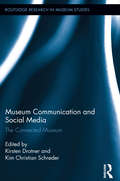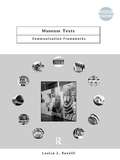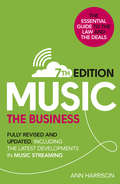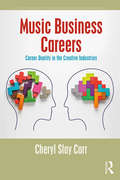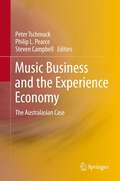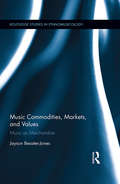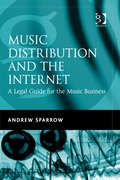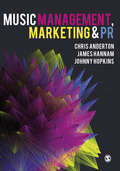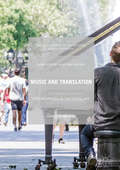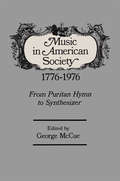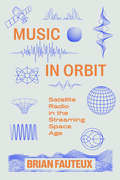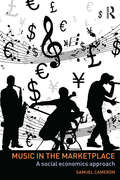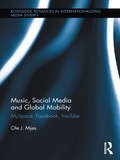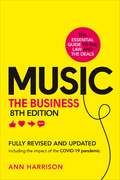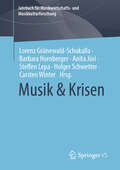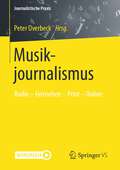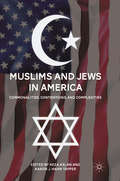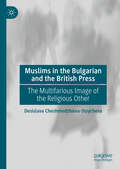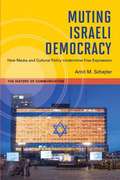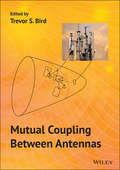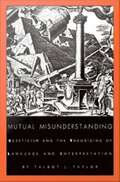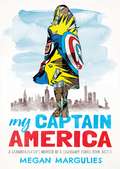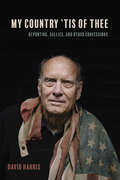- Table View
- List View
Murrow: His Life and Times
by A. M. SperberMurrow is the biography of America's foremost broadcast journalist, Edward R. Murrow. At twenty-nine, he was the prototype of a species new to communications--an eyewitness to history with the power to reach millions. His wartime radio reports from London rooftops brought the world into American homes for the first time. His legendary television documentary "See It Now" exposed us to the scandals and injustices within our own country. Friend of Presidents, conscience of the people, Murrow remained an enigma--idealistic, creative, self-destructive. In this portrait, based on twelve years of research, A. M. Sperber reveals the complexity and achievements of a man whose voice, intelligence, and honesty inspired a nation during its most profound and vulnerable times.
Museum Communication and Social Media: The Connected Museum (Routledge Research in Museum Studies #6)
by Kirsten Drotner Kim Christian SchrøderVisitor engagement and learning, outreach, and inclusion are concepts that have long dominated professional museum discourses. The recent rapid uptake of various forms of social media in many parts of the world, however, calls for a reformulation of familiar opportunities and obstacles in museum debates and practices. Young people, as both early adopters of digital forms of communication and latecomers to museums, increasingly figure as a key target group for many museums. This volume presents and discusses the most advanced research on the multiple ways in which social media operates to transform museum communications in countries as diverse as Australia, Denmark, Germany, Norway, the UK, and the United States. It examines the socio-cultural contexts, organizational and education consequences, and methodological implications of these transformations.
Museum Texts: Comunication Frameworks (Museum Meanings)
by Louise RavelliAnswering key questions in the study of how museums communicate, Louise Ravelli provides a set of frameworks to investigate the complexities of communication in museums: * What is an appropriate level of complexity for a written label?* Why do some choice in language make a more direct relation to visitors?* Is there a correct way of presenting a particular view of content?* How do design practices contribute to the overall meanings being made? The frameworks enhance the way we critically analyze and understand museums text, both in the sense of conventional – written texts in museums – and in an expanded sense of the museum as a whole operating as a communicative text. Using a wide range of examples Ravelli argues that communication contributes fundamentally to what a museum is, who it relates to and what it stands for. Not only museum studies and communications studies students, but also professionals in the field will find Museum Texts an indispensable guide on communication frameworks.
Music (7th edition): Fully Revised and Updated, including the latest developments in music streaming
by Ann HarrisonThis essential and highly acclaimed guide, now updated and revised in its seventh edition, explains the business of the British music industry. Drawing on her extensive experience as a media lawyer, Ann Harrison offers a unique, expert opinion on the deals, the contracts and the business as a whole. She examines in detail the changing face of the music industry and provides absorbing and up-to-date case studies. Whether you’re a recording artist, songwriter, music business manager, industry executive, publisher, journalist, media student, accountant or lawyer, this practical and comprehensive guide is indispensable reading. Fully revised and updated. Includes: · The current types of record and publishing deals, and what you can expect to see in the contracts· A guide to making a record, manufacture, distribution, branding, marketing, merchandising, sponsorship, band arrangements and touring · The most up-to-date information on music streaming, digital downloads, online marketing and piracy· An in-depth look at copyright law and related rights· Case studies illustrating key developments and legal jargon explained.
Music Business Careers: Career Duality in the Creative Industries (Routledge Research in Creative and Cultural Industries Management)
by Cheryl Slay CarrThe music industry offers the opportunity to pursue a career as either a creative (artist, producer, songwriter, etc.) or as a music business "logician" (artist manager, agent, entertainment attorney, venue manager, etc.). Though both vocational paths are integral to the industry’s success, the work of calling songs into existence or entertaining an audience differs from the administrative aspects of the business, such as operating an entertainment company. And while the daily activities of creatives may differ from those of the music business logician, the music industry careerist may sense a call to Career Duality, to work on both sides of the industry as a Career Dualist, a concept this book introduces, defines, and explores in the context of the music industry. This new volume speaks to the dilemma experienced by those struggling with career decisions involving whether to work in the industry using their analytical abilities, or to work as a creative, or to do both. The potential financial challenges encountered in working in the industry as an emerging artist may necessitate maintaining a second and simultaneous occupation (possibly outside the industry) that offers economic survival. However, this is not Career Duality. Likewise, attending to the business affairs that impact all creatives is not Career Duality. Rather, Career Duality involves the deliberate pursuit of a dual career as both a music industry creative and music business logician, which is stimulated by the drive to express dual proclivities that are simultaneously artistic and analytical. By offering a Career Duality model and other constructs, examining research on careers, calling, authenticity and related concepts, and providing profiles of music industry dualists, this book takes readers on a journey of self-exploration and offers insights and recommendations for charting an authentic career path. This is a practical examination for not only music industry professionals and the entertainment industry, but for individuals interested in expressing both the analytical and artistic self in the context of career.
Music Business and the Experience Economy
by Philip L. Pearce Peter Tschmuck Steven CampbellMusic Business and the Experience Economy is the first book on the music business in Australasia from an academic perspective. In a cross-disciplinary approach, the contributions deal with a wide-range of topics concerning the production, distribution and consumption of music in the digital age. The interrelationship of legal, aesthetic and economic aspects in the production of music in Australasia is also highlighted as well as the emergence of new business models, the role of P2P file sharing, and the live music sector. In addition, the impact of the digital revolution on music experience and valuation, the role of music for tourism and for branding, and last but not least the developments of higher music education, are discussed from different perspectives.
Music Commodities, Markets, and Values: Music as Merchandise (Routledge Studies in Ethnomusicology)
by Jayson Beaster-JonesThis book examines music stores as sites of cultural production in contemporary India. Analyzing social practices of selling music in a variety of retail contexts, it focuses upon the economic and social values that are produced and circulated by music retailers in the marketplace. Based upon research conducted over a volatile ten-year period of the Indian music industry, Beaster-Jones discusses the cultural histories of the recording industry, the social changes that have accompanied India’s economic liberalization reforms, and the economic realities of selling music in India as digital circulation of music recordings gradually displaced physical distribution. The volume considers the mobilization of musical, economic, and social values as a component of branding discourses in neoliberal India, as a justification for new regimes of legitimate use and intellectual property, as a scene for the performance of cosmopolitanism by shopping, and as a site of anxiety about transformations in the marketplace. It relies upon ethnographic observation and interviews from a variety of sources within the Indian music industry, including perspectives of executives at music labels, family-run and corporate music stores, and hawkers in street markets selling counterfeit recordings. This ethnography of the practices, spaces, and anxieties of selling music in urban India will be an important resource for scholars in a wide range of fields, including ethnomusicology, anthropology, popular music studies, and South Asian studies.
Music Distribution and the Internet: A Legal Guide for the Music Business
by Andrew SparrowThere is hardly an aspect of internet music promotion, sale and distribution which does not have a legal dimension. Since the stakeholders in the process includes artists, their managers, music publishers, record companies, distribution companies and the consumer, the law relating to internet music distribution is extremely complex. Andrew Sparrow's Music Distribution and the Internet provides those connected to the music and media industries with a guide to the legal requirements they must meet, answering questions such as: ¢ How should you conclude contracts with consumers over the internet? ¢ What are the various legal terms and conditions that should govern the sale of physical product to online music buyers? ¢ How should a website user's personal information be handled? ¢ What limitations are there on the way this data may be used for ongoing marketing of an artist's work or the merchandise associated with it? ¢ What are the latest copyright laws in this area and how do they apply to the internet? The book provides practical advice on how to approach key relationships with the internet buying consumer and other online media providers. The law is explained in straightforward terms and applied throughout in a music business context. Music Distribution and the Internet is an essential reference for anyone seeking to exploit and protect their rights and those of their artists in the rapidly expanding, constantly evolving and fascinating arena that is new media.
Music Management, Marketing and PR
by Chris Anderton James Hannam Johnny HopkinsThis book is your guide to the study and practice of music management and the fast-moving music business of the 21st century. Covering a range of careers, organisations, and practices, this expert introduction will help aspiring artists, managers, and executives to understand and succeed in this exciting sector. Featuring exclusive interviews with industry experts and discussions of well-known artists, it covers key areas such as artist development, the live music sector, fan engagement, and copyright. Other topics include: Managing contracts and assembling teams. Using data audits of platforms to adapt campaigns. Shaping opinions about music, musicians, events. How the music industry can be more diverse, inclusive, and equitable for the benefit of all. Working with venues, promoters, booking agents, and tour managers. Branding, sponsorship, and endorsement. Funding, crowdsourcing and royalty collection. Ongoing digital developments such as streaming income and algorithmic recommendation. Balancing the creative and the commercial, it is essential reading for students of music management, music business, and music promotion – and anybody looking to build their career in the music industries. Dr Chris Anderton, Johnny Hopkins, and James Hannam all teach on the BA Music Business at the Faculty of Business, Law and Digital Technologies at Solent University, Southampton, UK.
Music Management, Marketing and PR
by Chris Anderton James Hannam Johnny HopkinsThis book is your guide to the study and practice of music management and the fast-moving music business of the 21st century. Covering a range of careers, organisations, and practices, this expert introduction will help aspiring artists, managers, and executives to understand and succeed in this exciting sector. Featuring exclusive interviews with industry experts and discussions of well-known artists, it covers key areas such as artist development, the live music sector, fan engagement, and copyright. Other topics include: Managing contracts and assembling teams. Using data audits of platforms to adapt campaigns. Shaping opinions about music, musicians, events. How the music industry can be more diverse, inclusive, and equitable for the benefit of all. Working with venues, promoters, booking agents, and tour managers. Branding, sponsorship, and endorsement. Funding, crowdsourcing and royalty collection. Ongoing digital developments such as streaming income and algorithmic recommendation. Balancing the creative and the commercial, it is essential reading for students of music management, music business, and music promotion – and anybody looking to build their career in the music industries. Dr Chris Anderton, Johnny Hopkins, and James Hannam all teach on the BA Music Business at the Faculty of Business, Law and Digital Technologies at Solent University, Southampton, UK.
Music and Translation: New Mediations in the Digital Age (Palgrave Studies in Translating and Interpreting)
by Lucile DesblacheThis book explores how transformations and translations shape musical meanings, developments and the perception of music across cultures. Starting with the concept of music as multimodal text, the author understands translation as the process of transferring a text from one language – verbal or not – into another, interlingually, intralingually or intersemiotically, as well as the products that are derived from this process. She situates music and translation within their contemporary global context, examining the tensions between local and global, cosmopolitan and national, and universal and specific settings, to arrive at a celebration of the translational power of music and an in-depth study of how musical texts are translated. This book will be of interest to translation studies scholars who want to broaden their horizons, as well as to musicians and music scholars seeking to understand how cultural exchange and dissemination can be driven by translation.
Music in American Society: From Puritan Hymn To Synthesizer
by George McCueThis book is the literary legacy of a national music festival in St. Louis, organized to identify as clearly as possible the specifically native character of music originating in the United States of America. The festival—the Bicentennial Horizons of American Music and the Performing Arts (B.H.A.M.)—sponsored more than 250 performances and workshops between Flag Day and Independence Day 1976. It was the only event of the Bicentennial celebration to address itself to a survey and evaluation of the musical development of this country.
Music in Orbit: Satellite Radio in the Streaming Space Age
by Brian FauteuxYears before the advent of music streaming, Sirius and XM established satellite radio services that attracted paying subscribers through their ever-expanding lineup of niche music channels and exclusive celebrity-hosted programming. Music in Orbit is the first book to explore how satellite radio bridges legacy broadcast music radio and streaming platforms, serving as both precursor and integral player in today's streaming media environment. Arguing for the ongoing significance of radio in the digital age and the pernicious effects of monopoly power on the vibrancy of contemporary music industries, Music in Orbit offers essential context for the serious problems now facing working musicians, music consumers, and music communities.
Music in the Marketplace: A social economics approach
by Samuel CameronMuch recent economic work on the music industry has been focused on the impact of technology on demand, with predictions being made of digital copyright infringement leading to the demise of the industry. In fact, there have always been profound cyclical swings in music media sales owing to the fact that music always has been, and continues to be, a discretionary purchase. This entertaining and accessible book offers an analysis of the production and consumption of music from a social economics approach. Locating music within the economic analysis of social behaviour, this books guides the reader through issues relating to production, supply, consumption and trends, wider considerations such as the international trade in music, and in particular through divisions of age, race and gender. Providing an engaging overview of this fascinating topic, this book will be of interest and relevance to students and scholars of cultural economics, management, musicology, cultural studies and those with an interest in the music industry more generally.
Music, Social Media and Global Mobility: MySpace, Facebook, YouTube (Routledge Advances in Internationalizing Media Studies)
by Ole J. MjosThis book is about the relationship between media, communication and globalization, explored through the unique empirical study of electronic music practitioners’ use of the global social media: MySpace, Facebook, YouTube and Twitter. To understand the significance of the emerging nexus between social media and music in a global context, the book explores various aspects of production, distribution and consumption among electronic music practitioners as they engage with global social media, as well as a historical, political and economic exposition of the rise of this global social media environment. Drawing on interview-based research with electronic music artists, DJs, producers and managers, together with the historical portrayal of the emergence of global social media this pioneering study aims to capture a development taking place in music culture within the wider transformations of the media and communications landscape; from analogue to digital, from national to global, and from a largely passive to more active media use. In doing so, it explores the emergence of a media and communications ecology with increased mobility, velocity and uncertainty. The numerous competing, and rapidly growing and fading social media exemplify the vitality and volatility of the transforming global media, communication and cultural landscape. This study suggests that the music practitioner’s relationship with MySpace, Facebook, YouTube and Twitter and the key characteristics of these global social media, alter aspects of our practical and theoretical understandings of the process of media globalization. The book deploys an interdisciplinary approach to media globalization that takes into account and articulates this relationship, and reflects the enduring power equations and wider continuities and changes within the global media and communications sphere.
Music: The Business (8th edition)
by Ann HarrisonThis essential and highly acclaimed guide, now updated and revised in its eighth edition, explains the business of the British music industry.Drawing on her extensive experience as a media lawyer, Ann Harrison offers a unique, expert opinion on the deals, the contracts and the business as a whole. She examines in detail the changing face of the music industry and provides absorbing and up-to-date case studies.Whether you're a recording artist, songwriter, music business manager, industry executive, publisher, journalist, media student, accountant or lawyer, this practical and comprehensive guide is indispensable reading.Fully revised and updated. Includes:· The current types of record and publishing deals, and what you can expect to see in the contracts· A guide to making a record, manufacture, distribution, branding, marketing, merchandising, sponsorship, band arrangements and touring· Information on music streaming, digital downloads and piracy· The most up-to-date insights on how the COVID-19 crisis has affected marketing· An in-depth look at copyright law and related rights· Case studies illustrating key developments and legal jargon explained.
Musik & Krisen (Jahrbuch für Musikwirtschafts- und Musikkulturforschung)
by Holger Schwetter Lorenz Grünewald-Schukalla Carsten Winter Anita Jóri Steffen Lepa Barbara HornbergerDie vergangenen Jahre waren für Musikkultur und Musikwirtschaft durch tiefe Krisen gekennzeichnet. Die Maßnahmen gegen die Covid-19 Pandemie griffen nicht nur tief in den Alltag der Menschen ein, sondern mit der zeitweisen Absage jeglicher Clubveranstaltungen, Festivals und dem öffentlichen Konzertwesen kam ausgerechnet jener Bereich komplett zum Erliegen, der in den Jahren davor ein starkes Wachstum verzeichnet hatte und im Tonträgermarkt wegbrechende Einnahmen kompensierte. Für viele AkteurInnen der Branche ist damit zumindest kurzfristig die gesamte Existenzgrundlage zusammengebrochen. Der vorliegende Band richtet sich an ForscherInnen wie auch PraktikerInnen aus Musikwirtschaft und Musikkultur und betrachtet das Thema aus diesem Anlass einmal ganz grundlegend. Denn Musik kann auch und gerade in Krisenzeiten vielfältige Rollen spielen: Sie kann Stellung beziehen, Trends thematisieren oder geteilten Emotionen eine Form geben. Zugleich steckt in jeder Krise ein transformatorisches Potential: Krisen beschleunigen Entwicklungen und können hierzu leider auch missbraucht werden. Der Band liefert Beiträge zu Fragen wie: Wie haben MusikkünstlerInnen auf die Corona-Situation reagiert? Wie verändern sich gegenwärtig der Musikmarkt und Musikkulturen? Welche Rolle spielt (und spielte) Musik in Transformationsprozessen, die durch Krisen ausgelöst werden?
Musikjournalismus: Radio – Fernsehen – Print – Online (Journalistische Praxis)
by Peter OverbeckDieses Buch vermittelt die Grundlagen des Musikjournalismus. Erfahrene Praktiker informieren über die verschiedenen journalistischen Tätigkeiten – von der Programmgestaltung über die Musikkritik bis zur Moderation von Musiksendungen und Interviews mit Musikern in den Musiksparten von Klassik bis Pop. Die Besonderheiten in Radio, Fernsehen, Print und Online werden anhand zahlreicher Beispiele analysiert, die Funktion und der Einsatz von Musik sowie sprachliche, dramaturgische und gestalterische Mittel erörtert. Es gibt Tipps zum Berufsbild und zur Ausbildung und zu den vielfältigen Tätigkeiten.
Muslims and Jews in America
by Reza Aslan Aaron J. Hahn TapperThis book is an exploration of contemporary Jewish-Muslim relations in the United States and the distinct ways in which these two communities interact with one another in the American context. Each essay discusses a different episode from the recent twentieth and current twenty-first century American milieu that links these two groups together.
Muslims in the Bulgarian and the British Press: The Multifarious Image of the Religious Other
by Desislava Cheshmedzhieva-StoychevaThis book compares the ways in which the national media in two different countries construct (frame) and develop the image of the religious other, in this case Muslims in all their variety. Although it introduces concepts such as race and racism, otherness, Orientalism and Islamophobia, which may be familiar to the majority of readers, in this manuscript they serve the purpose of a comparative analysis which has not been done on the subject to date. The manuscript analyzes the thematic distribution of the articles, as well as the definitions, metaphors and stereotypes used, thus presenting a complete and diverse image of Muslims along with the similarities and differences in the thinking patterns employed by Bulgarians and British on the subject and expressed in the respective mainstream media. In this respect the manuscript fills a void in the scholarly literature on the ways the media discourses in two very different countries present the image of a religious group. Here we can even talk about the existing divide between East and West and the changing perception of the religious Other fostered by the general digitalization and free flow of information. As English is an international language it undeniably makes access to information easier, however, there are not many culture specific studies presenting the current state of a problem or the analyses on that particular topic (the image of Muslims) in that international medium. Therefore, the manuscript aims at introducing English speaking scholars, students, media people, and generally everyone interested in the topic, to the Bulgarian way of seeing, depicting and talking about Muslims. As stated above, the manuscript draws parallels between the language used by the Bulgarian and the British media, thus providing a similar starting point as the majority of the potential readers are probably more familiar with the latter. In addition, scholars working extensively with other local cultures and/or media and resorting to English as a medium for the popularization of their research, can use the presented analytical frame to their specific analyses and contribute even further to the enrichment of the global data base on the topic.
Muting Israeli Democracy: How Media and Cultural Policy Undermine Free Expression
by Amit M. SchejterThe result of years of critical analysis of Israeli media law, this book argues that the laws governing Israeli electronic media are structured to limit the boundaries of public discourse. Amit M. Schejter posits the theory of a "mute democracy," one in which the media are designed to provide a platform for some voices to be heard over others. While Israel's institutions may be democratic, and while the effect of these policies may be limited, this book contends that free speech in Israel is institutionally muted to ensure the continued domination of the Jewish majority and its preferred interpretation of what Israel means as a Jewish-democratic state. Analyzing a wide range of legal documents recorded in Israel from 1961 to 2007, Muting Israeli Democracy demonstrates in scrupulous detail how law and policy are used to promote the hegemonic national culture through the constraints and obligations set on electronic media.
Mutual Coupling Between Antennas
by Trevor S BirdMutual Coupling Between Antennas A guide to mutual coupling between various types of antennas in arrays such as wires, apertures and microstrip patches or antennas co-sited on platformsMutual Coupling Between Antennas explores the theoretical underpinnings of mutual coupling, offers an up-to-date description of the physical effects of mutual coupling for a variety of antennas, and contains techniques for analysing and assessing its effects. The book puts the topic in historical context, presents an integral equation approach, includes the current techniques, measurement methods, and discusses the most recent advances in the field.With contributions from noted experts on the topic, the book reviews practical aspects of mutual coupling and examines applications that clearly demonstrate where the performance is impacted both positively and negatively. Mutual Coupling Between Antennas contains information on how mutual coupling can be analysed with a wide range of methods from direct computer software using discrete methods, to integral equations and Greens function methods as well as approximate asymptotic methods. This important text:Provides a theoretical background for understanding mutual coupling between various types of antennasDescribes the interaction that occurs between antennas, both planned and unplannedExplores a key aspect of arrays in any wireless, radar or sensing system operating at radio frequenciesOffers a groundbreaking book on antenna mutual couplingWritten for antenna engineers, technical specialists, researchers and students, Mutual Coupling Between Antennas is the first book to examine mutual coupling between various types of antennas including wires, horns, microstrip patches, MIMO antennas, co-sited antennas and arrays in planar or conformal configurations.
Mutual Misunderstanding: Scepticism and the Theorizing of Language and Interpretation
by Talbot J. TaylorDo others understand what we say or write? Do we understand them? Theorists of language and interpretation claim to be more concerned with questions about "what" we understand and "how" we understand, rather than with the logically prior question "whether" we understand each other. An affirmative answer to the latter question is apparently taken for granted. However, in Mutual Misunderstanding, Talbot J. Taylor shows that the sceptical doubts about communicational understanding do in fact have a profoundly important, if as yet unacknowledged, function in the construction of theories of language and interpretation. Mutual Misundertanding thus presents a strikingly original analysis of the rhetorical patterns underlying Western linguistic thought, as exemplified in the works of John Locke, Jacques Derrida, Gottlob Frege, Jonathan Culler, Noam Chomsky, Ferdinand de Saussure, H. Paul Grice, Michael Dummet, Stanley Fish, Alfred Schutz, Barbara Herrnstein Smith, Harold Garfinkel, and others. This analysis reveals how, by the combined effect of appeals to "commonsense" and anxieties about implications of relativism, scepticism has a determining role in the discursive development of a number of the intellectual disciplines making up the "human sciences" today, including critical theory, literary hermeneutics, philosophy of language and logic, communication theory, discourse and conversation analysis, pragmatics, stylistics, and linguistics. Consequently, this provocative study will be of value to readers from a wide variety of disciplinary backgrounds.
My Captain America: A Granddaughter's Memoir of a Legendary Comic Book Artist
by Megan MarguliesA finely wrought coming-of-age memoir about the author&’s relationship with her beloved grandfather Joe Simon, cartoonist and co-creator of Captain America.In the 1990s, Megan Margulies&’s Upper West Side neighborhood was marked by addicts shooting up in subway stations, frequent burglaries, and the &“Wild Man of 96th Street,&” who set fires under cars and heaved rocks through stained glass church windows. The world inside her parents&’ tiny one-bedroom apartment was hardly a respite, with a family of five—including some loud personalities—eventually occupying the 550-square-foot space. Salvation arrived in the form of her spirited grandfather, Daddy Joe, whose midtown studio became a second home to Megan. There, he listened to her woes, fed her Hungry Man frozen dinners, and simply let her be. His living room may have been dominated by the drawing table, notes, and doodles that marked him as Joe Simon the cartoonist. But for Megan, he was always Daddy Joe: an escape from her increasingly hectic home, a nonjudgmental voice whose sense of humor was as dry as his farfel, and a steady presence in a world that felt off balance. Evoking New York City both in the 1980s and &’90s and during the Golden Age of comics in the 1930s and &’40s, My Captain America flashes back from Megan&’s story to chart the life and career of Rochester-native Joe Simon, from his early days retouching publicity photos and doing spot art for magazines, to his partnership with Jack Kirby at Timely Comics (the forerunner of Marvel Comics), which resulted in the creation of beloved characters like Captain America, the Boy Commandos, and Fighting American. My Captain America offers a tender and sharply observed account of Megan&’s life with Daddy Joe—and an intimate portrait of the creative genius who gave us one of the most enduring superheroes of all time.
My Country 'Tis of Thee: Reporting, Sallies, and Other Confessions
by David HarrisDavid Harris is a reporter, a clear-eyed idealist, an American dissident, and, as these selected pieces reveal, a writer of great character and empathy. Harris gained national recognition as an undergraduate for his opposition to the Vietnam War and was imprisoned for two years when he refused to comply with the draft. His writings trace a bright throughline of care for and attention to outsiders, the downtrodden, and those who demand change, and these eighteen pieces of long-form journalism, essays, and opinion writings remain startlingly relevant to the world we face today. This career-spanning collection of writings by an always-independent journalist follow Harris from his early days as a prominent leader of the resistance to the Vietnam War, through regular contributions to many publications, including Rolling Stone and the New York Times, and on into the twenty-first century.Born in Fresno and elected student body president of Stanford University in 1966, Harris has always had an undeniably Californian point of view—he imagines the future with an open heart and mind and pursues stories out of genuine curiosity, embedding himself among striking farmworkers, marijuana growers, the homeless on LA’s skid row, and occasionally, redwood trees. Inspiring, clarifying, and fearless, his abiding and lucid patriotism insists that our country live up to its own ideals.

